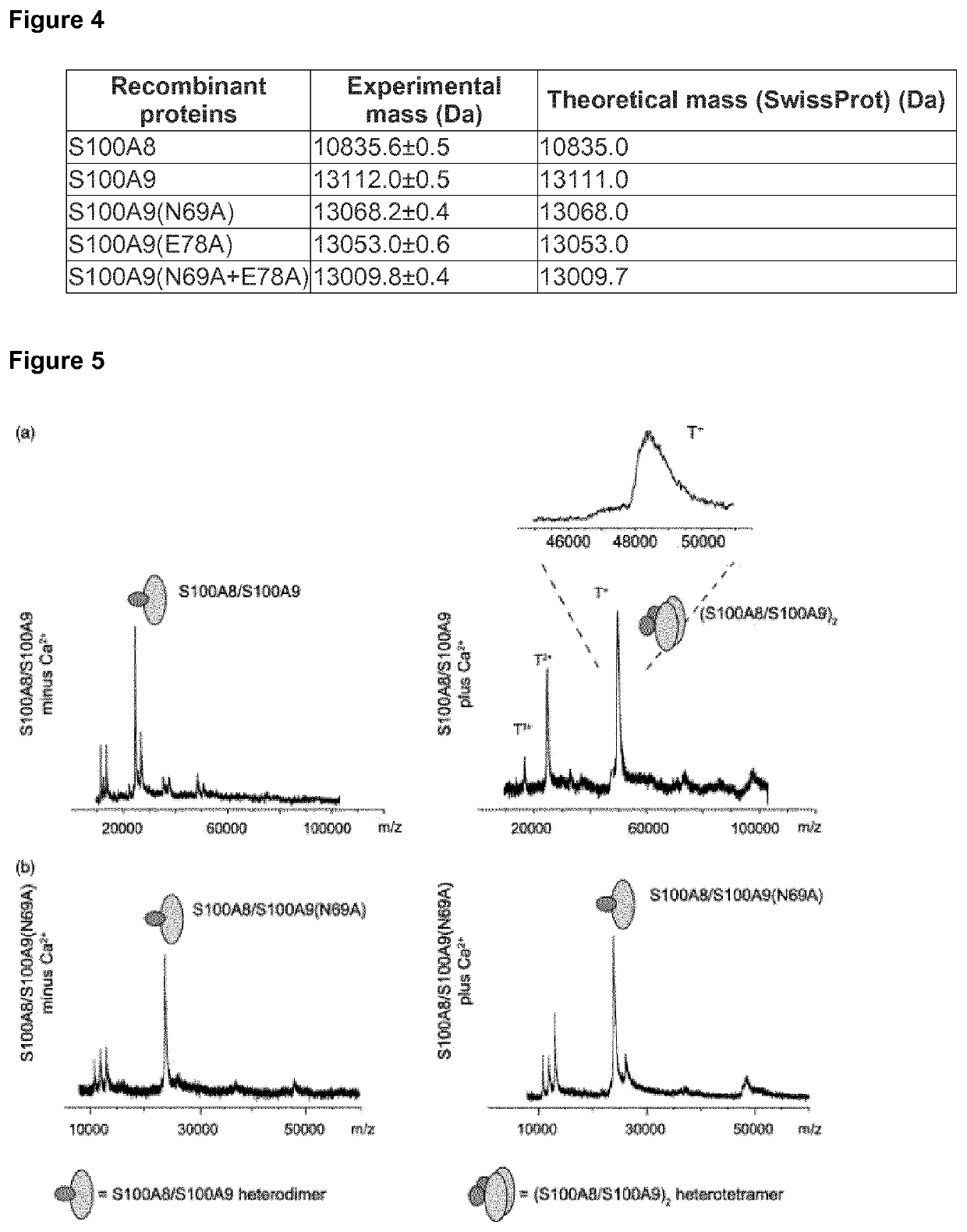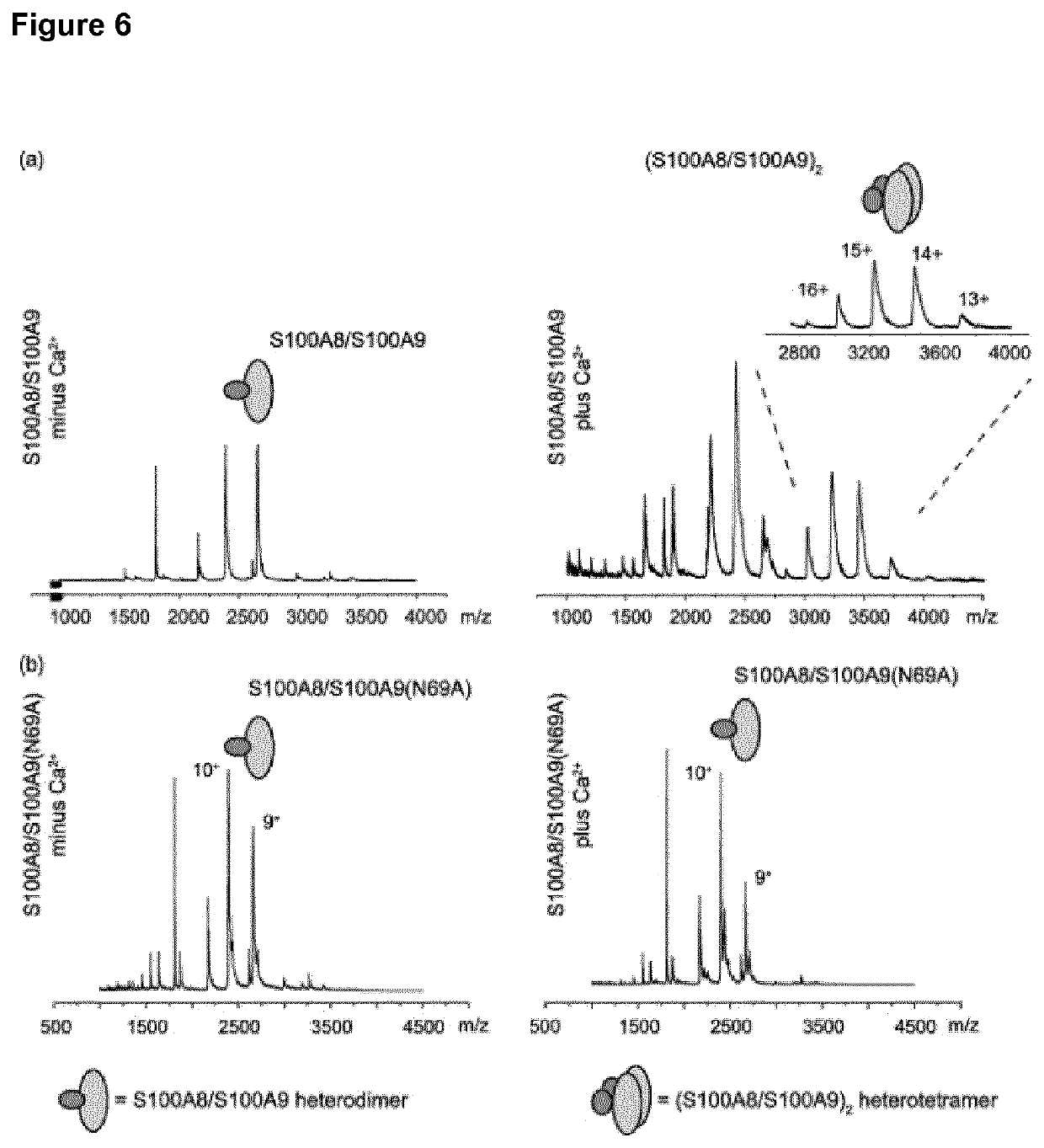Complex-specific standardization of immunological methods for the quantification of S100A12
a technology of immunological methods and complexes, applied in the field of mutations, can solve problems such as the inability to form tetramers or hexamers
- Summary
- Abstract
- Description
- Claims
- Application Information
AI Technical Summary
Benefits of technology
Problems solved by technology
Method used
Image
Examples
example 1
iation Between S100A8 / S100A9 Heterodimers and Teteramers Using MALDI-MS and ESI-MS
[0090]Electrospray ionization mass spectrometry (ESI-MS) confirms the theoretically calculated masses without the N-terminal methionine (SwissProt) for mutated and non-mutated recombinant S100A8 / S1009 proteins (FIG. 4).
[0091]S100A8 and S100A9 exist as heterodimers in the absence of calcium, and these heterodimeric complexes associate to (S100A8 / S100A9)2 tetramers upon calcium-binding. FIG. 5(a) shows the matrix-assisted laser desorption / ionisation mass spectrometry (MALDI-MS) spectra of the recS100A8 / S100A9 wt proteins. In the absence of calcium, samples show intense signals of singly charged heterodimers. In contrast, in the presence of Ca2+ wt S100A8 / S100A9 show a base peak in first shot spectra that corresponds to a singly charged heterotetramer (T+: 48 kDa) composed of two molecules recS100A8 and two molecules of recS100A9, respectively. Other prominent signals are detected at molecular masses of a...
example 2
es in Oligomerization States of S100A12 Wild Type and S100A12 Mutants
[0094]Glycerol centrifugation can be employed in order to confirm the different complex formation patterns as previously observed for S100A8 / S100A9 complexes. In EGTA-containing samples the recS100A12 wt and mutant rec S100A12E73A complexes are found in the same range of glycerol fractions 4-10 indicating that in the absence of calcium / zinc the formation of homodimers is preferred in wt proteins and the tested S100A12 mutant. In the presence of calcium or zinc alone wtS100A12 was found in the same fractions as observed before under EGTA-conditions, indicating that for S100A12 in contrast to S100A8 / S100A9 calcium alone is not sufficient to induce oligomerization. However, in the presence of calcium and zinc, wild type S100A12 complexes shifted to fractions of significantly higher numbers (9-15). This shift reflects the calcium / zinc-induced formation of high-molecular S100A12 tetramers and hexamers. In contrast, afte...
PUM
| Property | Measurement | Unit |
|---|---|---|
| w/w | aaaaa | aaaaa |
| size | aaaaa | aaaaa |
| affinity | aaaaa | aaaaa |
Abstract
Description
Claims
Application Information
 Login to View More
Login to View More - R&D
- Intellectual Property
- Life Sciences
- Materials
- Tech Scout
- Unparalleled Data Quality
- Higher Quality Content
- 60% Fewer Hallucinations
Browse by: Latest US Patents, China's latest patents, Technical Efficacy Thesaurus, Application Domain, Technology Topic, Popular Technical Reports.
© 2025 PatSnap. All rights reserved.Legal|Privacy policy|Modern Slavery Act Transparency Statement|Sitemap|About US| Contact US: help@patsnap.com



